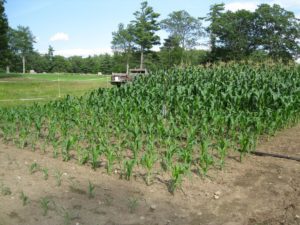Mar 2, 2023Sweet corn makes life green for growers
Sweet corn is one of the most profitable production systems for growers and frequently jumps to the top of the priority list for diverse specialty crop farms.
“Sweet corn is a super adaptable direct-seeded or transplanted successional grass crop requiring segregated blocks for wind pollination,” Ben Phillips, vegetable crops educator at Michigan State University, told an audience at the Great Lakes Fruit, Vegetable and Farm Market EXPO in December in Grand Rapids, Michigan.

The special characteristics of each class of sweet corn will appeal to different growers for different reasons. Genes provide different levels of sweetness and flavor to each kernel, and each type has some specific isolation requirements to ensure high quality and flavor.
Isolation can be achieved by physical space or by staggering planting times.
Here are basic descriptions of all the different types.
Normal sugar corn varieties (su) are the old-fashioned corn varieties that have a limited shelf life.

Sugary enhanced varieties (se and se+) have increased sweetness compared to normal sugary types. Because sugar levels are higher than su varieties, the sugar is more stable and kernels retain their sweetness longer than su types. These se and se+ varieties also have more of a “corn” flavor than sh2 types and the kernels have a creamier texture than sh2 types.
Supersweet varieties contain the “shrunken” (sh2) gene that increases sugar levels and greatly slows the conversion of sugar to starch.
Synergistic corn hybrids combine supersweet (sh2) and sugary enhanced (se) kernels in every ear. This provides the benefit of improved sweetness and shelf life combined with the flavor and tenderness of sugary enhanced genes.
Augmented types are similar to synergistic varieties, because they contain both sh2 and se kernels. Unlike synergistic types, all the kernels on the ears contain both sh2 and se genes.
“Sh2 sweet corn is tough,” Phillips said. “The syngergistics and the augmented are a way to get the softer skins of the se’s back into it and maintain sweetness over extended shelf life.”
Development process
Wind, not bees, transfers pollen from the male tassels to the female silks.
Cross-pollination occurs when pollen from one plant lands on the silks of another plant.
“The thing that’s unique about corn is that within the same season you can see the effects of cross-pollination,” Phillips said. “If you have a block of yellow and a block of white and they pollinate together you get bicolor in the same season.”
The preferred planting for sweet corn is to link them together by genetic groups. Su, se and synergistics can be planted near each other without adverse effects. Sh2 and shA (augmented supersweets) can be planted near each other to avoid adverse effects.
Sweet corn is usually direct-seeded. Up to the sixth leaf stage, the growing point is below ground. There is low germination in cold soils. It takes 20 days to germinate at 50˚ F – five days at 70˚ F.
“Wait for soil over 55˚ F for treated seeds and 65˚ F for untreated seed – especially sh2 varieties,” he said. “If it’s on the cool side, the shrunken seeds like the sh2’s don’t do so hot in the spring. Many people will start with a se or maybe some of the synergistics or something to start the season, but sh2’s are for a little later.
Multiple harvests
“You can plant corn all season long practically, into July (in Michigan), for longer markets,” he said. “The early market can be profitable. It’s achievable with transplants or plasticulture”.
With succession plantings of the same cultivar, once the first planting has sprouted, it’s time to do the next planting. Plant cultivars with different maturity dates at the same time. Cultivars generally mature from 60 to 100 days. Early cultivars, se’s and su’s germinate better under cold temperatures.
“Sometimes you can run a risk when transplanting, like any other fruiting vegetable,” Phillips said. “If they get distressed in the trays because you get behind with other things, they start to change the way that the hormones run through the plant and they get the signal to start fruiting.”
Sweet corn harvesting
Most people harvest by hand, but there are mechanical options.
“If you get smut, it can be a real mess, because that stuff breaks and smears all over everything, adding a whole extra process of washing,” he said. “If you’re hand-picking, you can avoid the smut and just not pick it.”
Postharvest considerations include recognizing that at 86˚ F, sugar is converted to starch quickly (up to 50% per day).
“No matter what, it’s important to pick in the morning because field heat can really wreck corn,” Phillips said.
It’s suggested that growers rapidly hydrocool or ice cool sweet corn to below 40˚ F, and store at 32˚ F. This slows sugar conversion down to 6% per day.
— Gary Pullano, Senior VGN Correspondent
Photo: To get a continuous supply of corn throughout the summer, plant a small amount of the same variety every 7-10 days or simultaneously plant varieties with different maturity dates. In this photo, each group of four rows was planted 7-10 days apart. The older corn on the right is almost ready to pick. The corn on the left will be ready in about 8 weeks. Photo: University of New Hampshire.
















